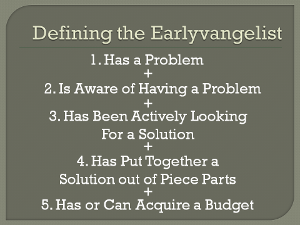Bill Brown was one at my last startup. He was the CTO of a VAR turned MSP in South Carolina that had spent his entire professional career in IT. When we found him, he had already cobbled together parts of a solution that for all intents and purposes had the basic functions of our product. Over the next 4+ years, he became one of our most vocal and demanding customers. He knew the needs of his organization, the limitations of the available technologies, and always seemed one step ahead of the market. He was one of the first to mention VPN-less installs, patch management, remote access through a proxy, and customer health reports - each of which became key features or innovations of our product. My engineering team would solicit his opinion at all phases of software development, and we eventually formalized his role as a member of our technical council. Bill was an earlyvangelist.
Defining Earlyvangelist
The Four Steps To the Epiphany, a book by Silicon Valley entrepreneur Steven Gary Blank, defines earlyvangelists as: “a special breed of customers willing to take a risk on your startup’s products or service because they can actually envision its potential to solve a critical and immediate problem.”
I had never heard the term earlyvangelist before The Four Steps To the Epiphany, but can not think of a more appropriate name. I had previously called these customers “innovators”, from the technology adoption lifecycle model made mainstream through the best selling book Crossing the Chasm. They have been present in all of my startups, and have been key drivers of my product strategies and roadmaps. They always wanted - no I should say demanded - something I did not have. When I was astute enough to listen to them, I found that more often than not, that they were right.
Finding Your Earlyvangelist
In the past, I could not define what I was looking for in an earlyvangelist, but knew one when I met them. Some times I would meet them at industry gathering, and other times I would meet them through an early sales cycle. They were almost always the prospective customer insisting on talking to engineering before closing a sale.
But Steven Gary Blank eliminates the subjectivity by providing one of the best definition I have seen. He classifies an earlyvangelist as a customer that:
- Has a problem
- Understands they have a problem
- Are actively searching for a solution
- Have cobbled together an interim solution
- Can acquire a budget for a solution to solve this problem
The real differentiation of course comes from points 4 and 5. Earlyvangelists have found the pain of the problem to be sufficiently acute that they did something about it: they solved it. Fortunately for you, the reason an earlyvangelist wants to talk is that their solution is incomplete - either costly to manage or lacking in features - and they have a keen interest in replacing with a product.
Parting Thoughts
The very existence of an earlyvangelist is validation that you are on the right track. I am certain you can build products and companies without them, but I couldn’t imagine choosing to take that risk. They frequently will surprise you with their insight into both the market and the technology, and almost always have an opinion not only of what you should do, but how you should do it. In short: they can be the difference between success and failure.
You can find Steven Blank's blog at steveblank.com. His book, The Four Steps To the Epiphany, details a customer driven development approach to building early stage products and companies, and is recommended reading. You can also follow him on Twitter at @sgblank.
Related Posts: Finding Your Founding Customers, Recommended Reading For Entrepreneurs, My Lean Startup Journey
